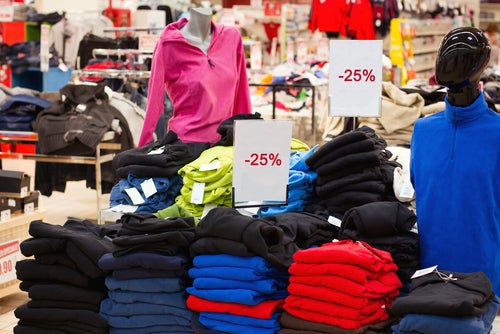
The “Mastering off-price fashion in an omnichannel world” report from McKinsey says in 2020 the off-price or discount segment grew faster than the market as a whole and it fell less during the pandemic too.
Between 2025 and 2030 the off-price segment will grow five times faster than the market overall.
The segment benefits from a strong online presence which puts its offerings in a good position to profit from the pandemic’s online shopping boom.
“Online sales account for 40% of the off-price market and they are growing extremely fast right now – about 13% annually, on average,” says Katharina Schumacher, a digital expert and author of the recent study.
“This development creates opportunities for fashion companies to have their brands reach new consumers who would not normally consider making a purchase at the full price.”
Many consumers in Europe made multiple online purchases during the past year. In the off-price segment, growth of online sales tripled – CAGR jumped from 9% in 2020 to 19% in 2021. Annual growth through 2025 is projected to be 13%. In addition, off-price provides a sustainable way for fashion brands to sell excess stock.

US Tariffs are shifting - will you react or anticipate?
Don’t let policy changes catch you off guard. Stay proactive with real-time data and expert analysis.
By GlobalDataOff-price shoppers, the report says, care about style and usually start shopping without a specific brand in mind. But they enjoy comparing prices and spend 2.3 times more on their purchases than other groups of fashion customers. In Germany, 30% of off-price customers spend more than EUR1,000 per year on fashion purchases – and account for 70% of total fashion spending. “At the same time, these buyers are fundamentally willing to pay the full price for premium and luxury brands,” says Achim Berg, a McKinsey expert on the fashion industry. “Fashion companies should therefore carefully weigh which products they offer off-price.”
Off-price shoppers who visit bricks-and-mortar stores are often younger and buy more than other fashion consumers. They enjoy going to outlet centres, but tend to avoid regular luxury stores in upscale shopping districts. “Outlets offer luxury fashion labels an opportunity to not only be more profitable, but also to reach new groups of customers without cannibalising their full-price assortment and damaging their brand,” says Felix Rölkens, another McKinsey fashion industry expert and co-author of the study. “But shoppers’ expectations for outlets are constantly growing: amenities that resemble those of regular stores, sales staff who speak several languages, restaurants, and a good customer experience.”
How can brands capitalise on the off-price opportunity?
Brands must take a multipronged strategy to maximise revenues for both channels and to secure their brand equity — without cannibalising full-price offerings. Brands that successfully navigate the off-price market will be able to ride its wave while also strengthening their overall position with consumers. Three priorities will be critical as fashion brands look to activate the off-price segment.
- Protect the brand across channels
The best operators of outlet malls and villages have created an excellent experience for shoppers while avoiding too much price and volume transparency. Because brands don’t want shoppers to know they can get goods on markdown a week later, the physical separation of outlet locations and high-street city centres has traditionally provided more comfort.
Online off-price platforms threatened to make pricing for every item just one click away, so brands were initially reluctant to participate. However, the emergence of closed off-price portals enables brands to disclose prices and discounts while keeping those barriers in place. Fashion brands should remain vigilant in understanding the reach and transparency of online platforms while staying up to date on new membership-based models.
2. Be discerning when choosing partners
The best off-price partners, regardless of model, will extend the reach of a brand. For the offline channel, brands should seek to identify partners with a network of outlets in other countries and markets. Customer experience should also be a priority to reinforce a brand’s distinctiveness. For the online channel, brands should evaluate their partner’s online experience (closed versus open) and brand selection to ensure their inventory does not suffer from being placed next to cheaper products.
3. Optimise the channel mix
Fashion companies should take a holistic view of how the offline and online channels can support each other across touchpoints. While the shift to online will occur rapidly over the next five years, offline outlets and villages will remain major destinations thanks to their exemplary experience. They can offer both immersive brand experiences and an opportunity to raise brand awareness among consumers. And because many consumers still get their first exposure to brands at these physical outlets, they are a potential gateway for extended engagement that can be reinforced by online channels.
Online has a compelling proposition for consumers: It provides a very convenient experience — with goods just one click away. Some players have standing assortments year-round to satisfy needs for items, while flash sales players offer a more gamified, bargain-hunting experience. And the online channel represents a sustainable way for brands to handle their overstock.
The predicted growth of off-price creates greater urgency for brands to develop a coherent strategy that can capture more value from this segment. The benefits —from increased profits to expanded reach and a sustainable way to sell overstock —more than justify the investment. The best fashion companies will take it a step further by elevating their brand’s reputation in the process.


